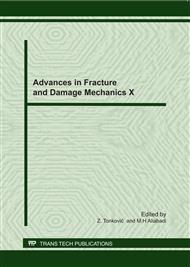p.89
p.93
p.97
p.101
p.105
p.109
p.113
p.117
p.122
Mechanical Characterization of Friction Stir Channels under Internal Pressure and In-Plane Bending
Abstract:
Friction Stir Channelling (FSC) is a simple and innovative technique of manufacturing integral and continuous channels (also referred as conformal channels) in monolithic plates in a single step. This paper is focused on the mechanical behaviour of integral and continuous FS channels produced in a monolithic plate of the aluminium alloy AA7178‑T6 with 13mm of thickness, typically used in structural aircraft applications. Internal pressure tests were conducted on specimens with a longitudinal friction stir channel. In-plane bending tests were carried out in specimens with longitudinal and transversal channels; different conditions were analysed for each FSC parameters set. Results were analysed and compared concerning the FS channels microstructure and base material mechanical properties. Bending tests results show that tool rotation speed has more influence in the FSC specimens bending strength than tool travel speed and internal pressure tests show that increase tool rotation speed increases the minimum pressure that leaking points arise.
Info:
Periodical:
Pages:
105-108
Citation:
Online since:
September 2011
Authors:
Price:
Сopyright:
© 2012 Trans Tech Publications Ltd. All Rights Reserved
Share:
Citation:


